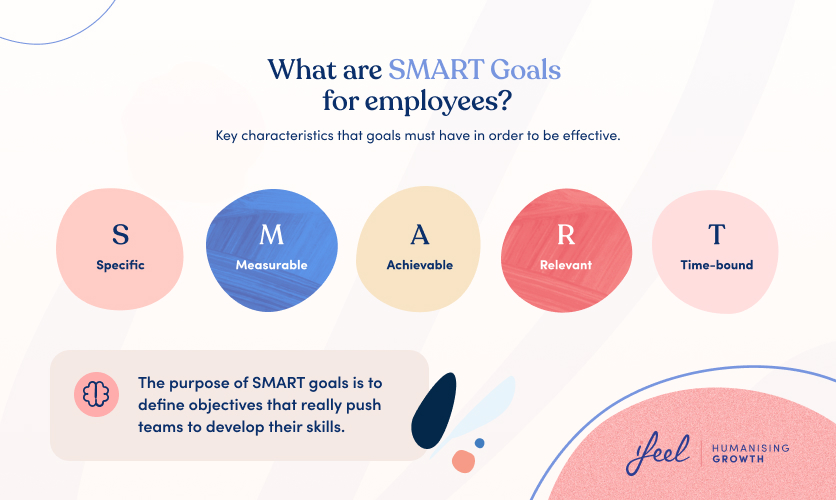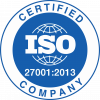In recent years, SMART goals for employees have surged in popularity. Defining effective goals and objectives is essential in the quest for continuous improvement and business success. Whether these objectives are monetary or relate to corporate well-being, setting goals charts the course for an organisation’s evolution.
Naturally, achieving these goals requires alignment from all team members, pursuing the same objectives. However, this process is more complex than it might appear.
To maximise employee performance, it is crucial to set smart, clear, achievable, and motivating goals. But how can you ensure the objectives you set meet these criteria? Keep reading, and we will guide you through the process of setting so-called SMART goals for employees, a proven approach that promotes team growth and development.

But… what are SMART goals for employees?
The term “SMART” in SMART goals is an acronym that describes the key characteristics that goals must have to be effective. This acronym also alludes to the English translation of the word “smart.” Thus, using SMART goals for employees is a strategy that aims to define objectives that truly drive teams to develop their skills.
Consequently, by following each letter, the SMART acronym means that the goals should be:
Specific: Objectives should be clear and precise, avoiding ambiguity. Define what needs to be achieved and why.
Measurable: Goals should be quantifiable so that progress can be assessed. Numbers and concrete data can be used for this purpose.
Achievable: We would all love to make great strides in short periods, but sometimes this is unrealistic. Therefore, goals should be feasible so that your team members can reach them. Unattainable goals often undermine employee motivation.
Relevant: The goals set should be related to the company’s strategic objectives and relevant to each employee’s role.
Time-bound: Finally, when defining the goal you want to achieve, you must also specify the time frame in which to work towards it. In other words, they should have a defined deadline for their achievement, creating a sense of urgency and commitment.

How to define SMART goals
Now that we know what characteristics a goal must have to be considered effective, we can apply this strategy to our work team. To do this, we must follow certain steps that will allow us to apply the SMART goals for employees. These are:
Step 1: Define specific objectives
The first step in establishing SMART objectives is to define them specifically. This means you should avoid vague and ambiguous goals. For example, instead of setting a vague goal like “increase sales,” you could define it as “increase sales by 10% in the next quarter in the B2B customer segment.” By describing it this way, confusion is avoided, and it clearly expresses what is intended to be achieved.
Step 2: Establish a measurement system
Objectives must be measurable so that progress can be objectively assessed. For this, always use quantitative data whenever possible. For example, using figures like “the number of followers to be gained,” “the number of new customers to increase,” “the percentage increase in sales,” etc., could be useful when defining and quantifying the objectives to be achieved.

Step 3: Ensure they are achievable
It’s important that objectives are achievable and realistic. Setting unattainable goals can not only demotivate team members but also generate frustration and anxiety. Therefore, a good leader who applies emotional intelligence at work takes care to evaluate the company’s resources and the capabilities of their team, adapting the goals accordingly.
This cares for their mental well-being and fosters a healthier and more productive work environment. By defining achievable goals, you promote confidence and motivation in your team.
Step 4: Make the objectives relevant
When setting SMART goals for employees, you must ensure that the objectives you propose are relevant to the company’s overall success and aligned with each employee’s role and responsibilities. Therefore, make sure the objectives you want to set have a positive impact on achieving the organisation’s strategic goals.
Step 5: Set time frames
Finally, assign deadlines for each objective. This creates a sense of urgency and commitment to work towards them. Establishing a specific timeframe allows employees to organise themselves based on the objectives, focus on the task, and measure their progress over time.
Unlocking your team’s potential
At ifeel, we believe that defining SMART goals for employees is a powerful tool for improving their performance and achieving business success. This strategy fosters a more effective approach, motivates teams, and contributes to the company’s growth.
Remember, the goal-setting process should be collaborative. Therefore, leaders should work closely with team members to define challenging but achievable goals that allow them to grow and contribute to the organisation’s success.
For this reason, our team of psychologists, experts in workplace well-being, has developed a mental well-being solution for businesses aimed at helping companies enhance their employees’ work commitment and boost productivity.
Thanks to this collaboration, Human Resources managers can receive personalised and data-based advice on the most effective measures to detect mental health issues in employees and measure the workplace atmosphere their team’s experience. It’s the best way to understand their needs.

On the other hand, ifeel’s mental well-being solution for organisations offers employees a structured mental health care service at various levels depending on their needs at any given time. In this way, they can access various mental health care tools through the app. At a second level, they can receive emotional support via a chat with one of the psychologists on our platform. If they prefer more continuous assistance over time, they only need to access the third level of the program: online psychological therapy with a psychologist specialised in cases like theirs.
We hope you found this article on the steps to designing SMART goals for employees interesting. We encourage you to read this article about self-care at work to learn more ways to increase workplace productivity.
Lastly, if you want more information about our mental well-being solution for businesses, simply request it, and we will contact your team promptly.










